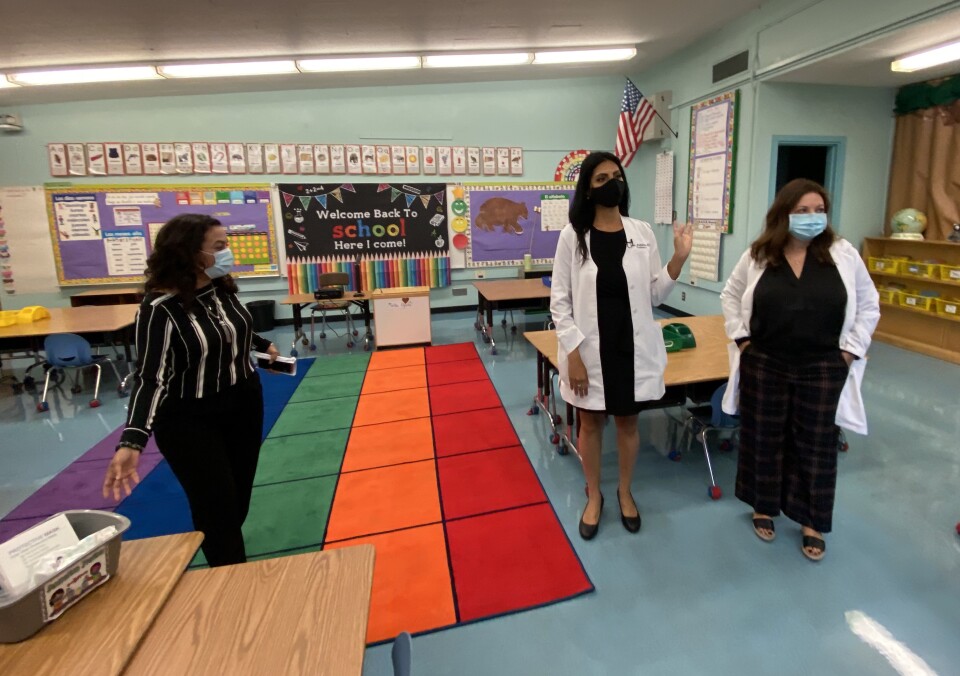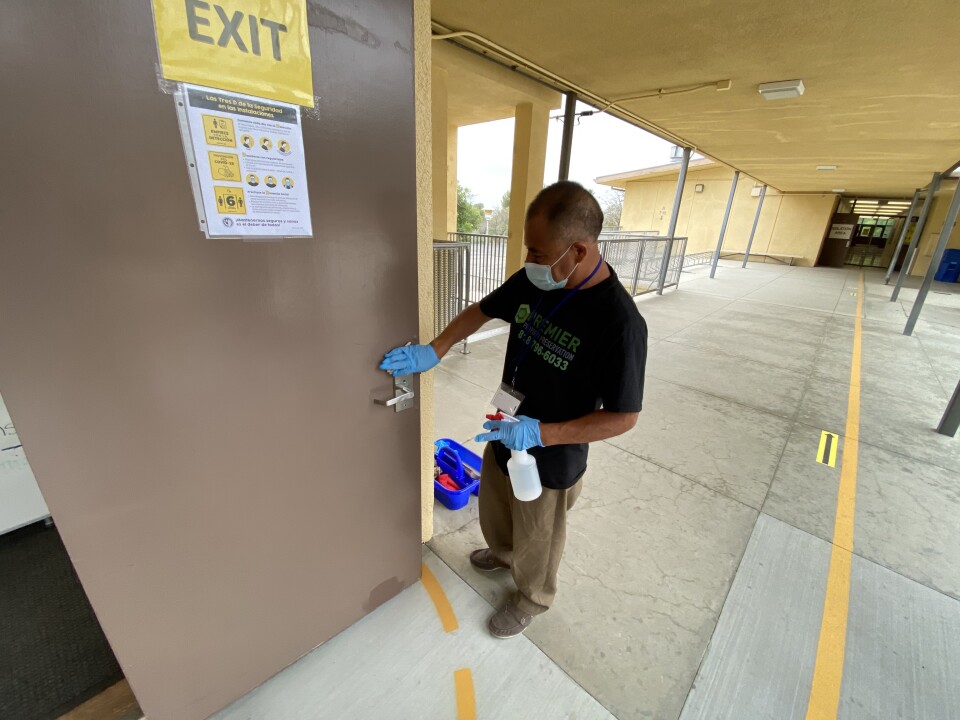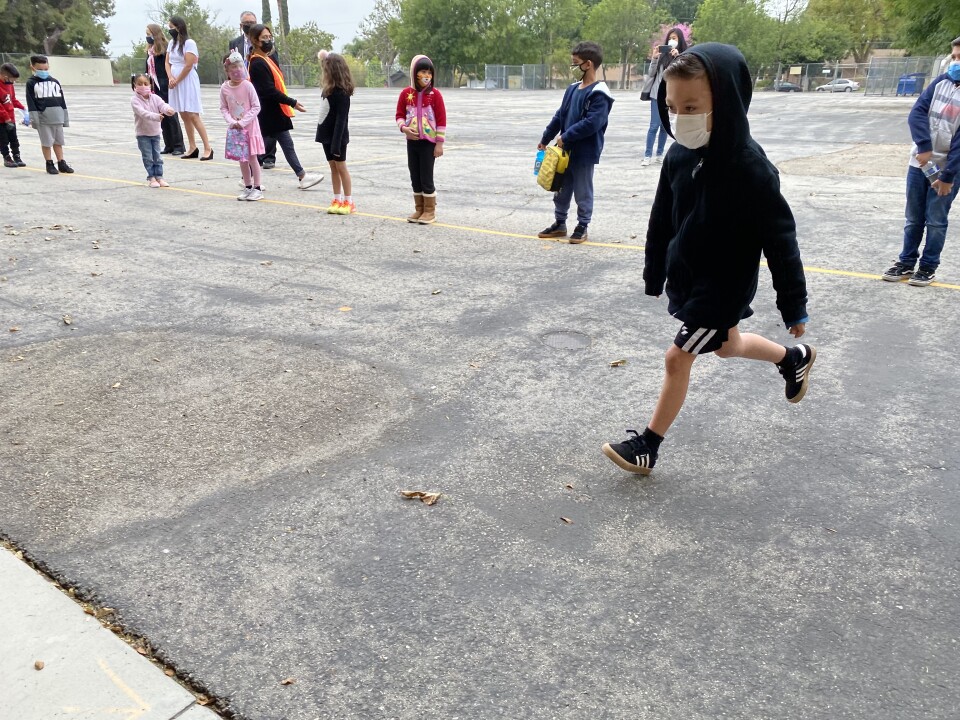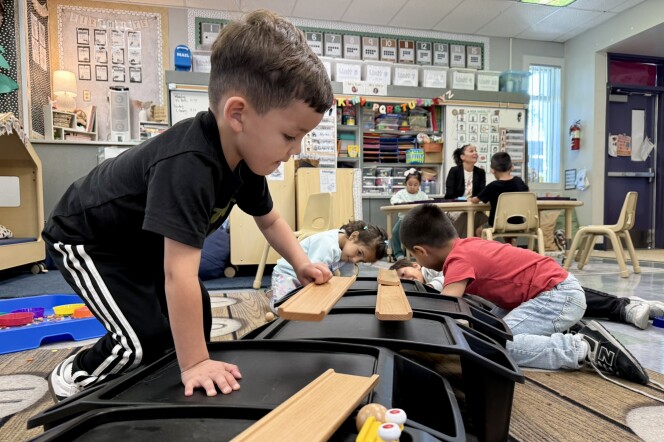With our free press under threat and federal funding for public media gone, your support matters more than ever. Help keep the LAist newsroom strong, become a monthly member or increase your support today.
Get Ready For LAUSD’s First Day: We Answer 8 Big Questions About Reopening Schools In A Pandemic

“Normal” is not the word Dr. Naomi Bardach would use to describe the upcoming school year in the Los Angeles Unified School District.
Students and teachers will still have to wear masks and take weekly COVID-19 tests, whether they’re vaccinated or not. LAUSD is still paying for a stepped-up cleaning regimen on its campuses.
“But I think compared to last year,” said Bardach — a practicing pediatrician and leader of the state’s Safe Schools for All team — life on campus this year “is going to feel a lot more familiar.”
No more Zoom-in-a-room classes. No more attending classes in morning or afternoon shifts, like students did last spring.
Most students will attend classes on-campus, five days a week, six hours per day.
With LAUSD kicking off its new school year on August 16, we’ve got answers to important questions about what to expect.
We’ve even included some topics LAUSD doesn’t cover in its official Back to School FAQ — which is definitely worth checking out for answers to more detailed questions.

1. The Delta variant has sent cases surging. Is going back to campuses safe?
Even with the latest surge, the U.S. Centers for Disease Control and Prevention says on-campus schooling is safe, if students and staff take now-familiar precautions — especially wearing masks. California is requiring masks in all schools. (The CDC also advises schools to maintain some social distancing rules.)
With those CDC-recommended precautions in place, the American Academy of Pediatrics has concluded the harms of missing in-person instruction “outweigh the risks [from the virus] in almost all circumstances.”
Bardach — who’s also a UC San Francisco professor and practicing pediatrician — said there’s very little evidence of COVID-19 spreading in schools “almost at all.” Studies have shown kids are far more likely to catch the virus at a party or a playdate than at school, she said; at school, students are wearing masks.
“It’s the environment that’s not the controlled school environment where COVID passes around,” Bardach said during a recent town hall.
Returning to in-person instruction is not without risk. School-aged children can get seriously sick with COVID-19, and children under 12 aren’t eligible for vaccines yet. The Delta variant spreads more easily — as easily as chickenpox, according to an internal CDC document obtained by The Washington Post.

In the last week of July, authorities reported an 85% increase nationwide in cases among children compared with the week before, according to data compiled by the American Academy of Pediatrics. (Case rates among adults have also spiked at a similar rate.)
Still, in an interview, Bardach said vaccines are “extremely effective” protection for adults and teens, and vaccinated people act as a buffer for unvaccinated children. While the Delta variant is more contagious for all age groups, she said the variant is still less likely to infect younger children or make them severely ill.
In schools, officials are confident they’ve put enough safeguards in place to prevent the virus from spreading on campus.
“We think very strongly that … our safety protocols create a safe environment,” said LAUSD Interim Superintendent Megan Reilly, “and in-person is the best venue for learning.”

2. What safety precautions are LAUSD schools taking to stop COVID-19 on campuses?
“It’s not back to business as usual,” noted LAUSD Medical Director Dr. Smita Malhotra, who told us the district will continue to lean on many now-familiar safety measures:
- Face masks. LAUSD will require students and staff to wear face coverings at all times on campus — including while outdoors. (That’s a step beyond both the county and state school guidance, which both recommend outdoor mask use, but don’t require it.) Limited exceptions to this rule will also be made for students with qualified disabilities or medical exemptions, and for staff who work with these students, according to an agreement with LAUSD’s teachers union.
- Health screenings at campus gates. At the entrance, a district staff member or volunteer will ask all entering students, employees and visitors to affirm that they haven’t had COVID-19 symptoms — or close contact with anyone showing symptoms — for the last 14 days. Students can fill out a form on the district’s Daily Pass website ahead of time, or they can answer the questions verbally at the gate.

- Weekly COVID-19 tests: LAUSD officials are now requiring all students and staff — whether they’re vaccinated or not — to take a COVID-19 test before allowing them to return to campus. Once classes begin, the district will send teams weekly to each campus to re-test all staff and students. Previously, LAUSD only planned to test unvaccinated individuals and student athletes, but the district changed its plans after the L.A. County Department of Public Health updated its guidance for K-12 schools. “We’re guided by the science,” Reilly said. “This protects us even more and it’s the right thing to do.”
- Stepped-up cleaning regimen: This year, LAUSD plans to spend tens of millions of dollars on additional custodial services, cleaning equipment, personal protective gear and supplies for air filtration systems. District plans say custodians will wipe down and sanitize high-touch surfaces throughout schools twice daily. They’ll also use electrostatic mister machines to disinfect many of these spaces each night, according to LAUSD’s documents.

3. What do I need to get my student ready to return to campus?
Aside from getting them comfortable with being around other children again, the most critical thing is to get your student tested for COVID-19 sometime before August 14.
The district has 12 testing locations where students can go to take this initial “baseline” test. Throughout the next two weeks, mobile testing teams will visit each school to offer these screenings to students a little closer to their homes. LAUSD principals should be reaching out to parents with more info about the screening visits.
In addition, students can also take a test from an outside provider and upload the results to the district’s Daily Pass website.
After classes begin on August 16, the district will test students and staff on campuses each week.
4. I don't want to send my student back to campus. What are my options?
LAUSD is offering an online option for this school year, though the program will be vastly different from last year’s distance learning model. And there are only a few days left to sign up.
While this year’s online program is open to all, the program isn’t for everyone. This is a program to guarantee an education for students with “medical, socio-emotional, or other concerns” — and choosing this model comes with real trade-offs.
Students will not be taught by teachers from their home school. They’ll technically be enrolling in a new school: LAUSD’s longstanding independent study program, City of Angels.
This means students won’t be able to switch easily between online and on-campus classes. LAUSD will accommodate students who change their minds, but the district is asking students who choose online to commit for at least a full semester.
In City of Angels, students won’t be able to participate in after-school activities. They may not be able to play sports for their home school. City of Angels won’t be able to offer the specialized instruction of a dual language school or magnet program. (We lay out some more of the differences here.)
If you want to sign your kid up, the district has extended the deadline to this Friday, August 6. Log onto the district’s Parent Portal, visit this website, or call (323) 415-8350 to start the process.
5. Is COVID-19 testing necessary, even for vaccinated students and staff?
Bardach believes LAUSD is less likely to have to quarantine a classroom or an entire school due to COVID-19 because of its testing plans, and that testing will be an effective tool for reducing spread.
To the extent that the Delta variant has created new uncertainty, “I actually think that testing gives us actionable information to say, ‘We’re doing fine,’” she said.
Bardach said making COVID-19 testing widely available will be crucial to ensuring schools reopen safely this fall — and there’s at least one statistical model backing her up: A group of researchers from Stanford, Harvard, the University of Maryland, and Massachusetts General Hospital ranked weekly coronavirus screenings as one of the most effective mitigation steps schools can take to tamp down outbreaks.

6. Will LAUSD enforce social distancing rules — and will class sizes be smaller?
Last spring, LAUSD adhered to the “six-foot rule,” a requirement that students and staff remain six feet apart at all times. Later in the spring, the CDC shortened the distance, giving birth to the “three-foot” rule.
There’s no longer any such hard-and-fast rule in L.A. County’s guidance to schools or in LAUSD’s reopening plans.
“The public health department has made it clear they want to bring as many students back to school in person,” said Malhotra, the district’s medical director, “so we will maximize physical distancing as much as possible.”

One example of an instance where LAUSD hopes to maintain some distance: in the lunch line, where schools will do their best to keep students six feet apart.
But without the need to space classroom seats six feet apart, class sizes in LAUSD will largely return to their pre-pandemic levels, though the district has specifically promised to reduce class sizes by two students in 4th through 12th grades.
Following county guidance, LAUSD’s containment plan suggests schools keep students in stable groups “when feasible” — but this is a guideline, not a requirement. That means, in elementary schools, “students will be allowed to safely play with other students during recess and lunch.”
This also means that middle and high schools will return to their pre-pandemic schedules. Unlike last spring — when on-campus instruction in LAUSD meant students attending online lectures from inside a classroom — students will once again switch classrooms between class periods.

7. What happens if there’s a case of COVID-19 at my student’s school?
Like they did last spring, schools will set up separate “isolation” and “quarantine” areas.
In short, a student who tests positive or comes down with symptoms while at school will be sent to the isolation area. Once dismissed from campus, the student will be asked to stay home until at least 10 days after their symptoms subside.
Any student who’s asymptomatic but has had contact with a confirmed COVID-19 case will be asked to report to the quarantine area.
An LAUSD employee will alert county health officials and notify anyone who may have had close contact with the student “to quarantine at home and test for COVID-19 five or more days after exposure.”
8. Could a COVID-19 outbreak force my student’s class — or school — to switch back to online schooling?
Yes.
Here’s what might happen: If three or more cases crop up within 14 days on the same campus, the L.A. County Department of Public Health will get actively involved. It will consult with LAUSD to determine whether to quarantine the infected cases, an entire classroom, or even the whole school.
According to the district’s containment plan, LAUSD officials then may decide to send students home to continue their studies in distance learning mode “to allow for [county officials] to investigate the COVID-19 situation” or to allow for a deeper cleaning of the campus.
Malhotra emphasized LAUSD will not make unilateral decisions about closing down schools: county officials will “help to decide for us which direction we need to go … We don’t make decisions in silos.”

There’s some ambiguity about exactly what “distance learning” would entail for a student in quarantine.
“While students are quarantining at home,” district officials said in a statement forwarded by a spokesperson, “the student will continue their learning with the curriculum currently used by the class or teacher. Every effort will be made to ensure continuity of learning.”
This scenario raises other questions: Would students go back to their distance learning schedule from last spring? How many minutes of live instruction with their teacher could they expect? Neither the teachers union agreement nor LAUSD’s containment plan answer these questions. LAUSD is positioning City of Angels as a long-term distance learning option, not a short-term solution for quarantining students.
Bardach — the pediatrician in charge of California’s Safe Schools for All team — believes the chances of whole-school quarantines, or district-wide shutdowns, are low.
“A classroom might get sent home,” Bardach said, while adding that LAUSD's weekly COVID-19 testing "decreases [the] likelihood by a fair amount” that an entire school would be forced into quarantine.

For what it’s worth: Interim Superintendent Reilly said LAUSD officials don’t have the power to revert the entire district into distance-learning mode. In their most recent budget agreement, Sacramento lawmakers changed state law to make it clear they want most students back in classrooms for in-person instruction, and their recent budget ties schools to this goal.
If L.A.’s public health conditions worsened significantly, Reilly said, “the state would have to intervene.”
That change in state law is the primary reason why this school year will feel, not normal, but “familiar” — even if some LAUSD families aren’t ready for that.
Corrected August 9, 2021 at 8:41 AM PDT
An earlier version of this post said district staff members will conduct temperature checks on students and visitors entering a campus. This month, LAUSD discontinued temperature screenings.







